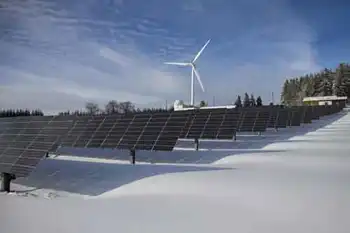North Dakota woos turbine manufacturers
The state Commerce Department has hired a British firm to help drum up business prospects in Europe, where a number of large wind energy companies are based. The contract of Chris Parkhouse, chief executive officer of the Deyton Bell consultancy in Cambridge, England, was recently extended until June 30, with a cost limit of $68,000.
Shane Goettle, the Commerce DepartmentÂ’s director, said Parkhouse helped arrange meetings with a half-dozen industry prospects at a wind energy conference in Chicago. He declined to identify them.
“It’s been a little slower, quite honestly.... Some of that activity has slowed down,” Goettle said. “But we’re now familiar with and been introduced to a number of companies, and we’ll continue to work those leads.”
The May conference, organized annually by the American Wind Energy Association, drew almost 1,300 businesses, seven governors and representatives from at least 19 state economic development agencies, according to the association. The Commerce Department had a booth in the conferenceÂ’s exhibit hall and plans a larger presence at the associationÂ’s 2010 trade show in Dallas.
Goettle said he emphasizes that North Dakota has a number of tax and job training incentives for manufacturers and that its location has easy access to both the United States and Canada.
“We pitch the fact that if they’re in the wind manufacturing industry, we’re the geographic center of North America,” he said.
North Dakota has enough wind turbines operating to generate more than 700 megawatts of power, and developers have announced plans to add an additional 6,000 megawatts, according to the state Public Service Commission. Each megawatt can provide enough electricity to serve about 300 homes for one year.
Even 7,000 megawatts is well below the stateÂ’s potential, according to the American Wind Energy Association. It says North Dakota is capable of producing 138,400 megawatts of wind power, the most of any state.
North Dakota has two principal manufacturers that supply the wind industry. West Fargo-based DMI Industries builds steel towers for wind turbines. LM Glasfiber, which is based in Denmark, operates a Grand Forks factory that makes turbine blades.
Goettle said the state was working to recruit companies that make parts for nacelles, the unit that converts wind energy into electricity. The nacelle — a French word that means “small boat” — sits atop the wind tower, and includes a generator, a gear box, a meter that measures wind speed and other equipment.
Gov. John Hoeven has met with executives of several leading wind energy companies, including General Electric, Siemens and Acconia, said his spokesman, Don Canton. Goettle said North Dakota companies may be interested in making parts for the nacelle.
Several states are looking to move beyond tower and blade manufacturing and into the more specialized realm of manufacturing and assembling nacelle components, said Elizabeth Salerno, the American Wind Energy AssociationÂ’s director of industry data and analysis.
Vestas Wind Systems A/S, a Danish company, is building plants to assemble nacelles and manufacture wind turbine blades in Brighton, Colo., and a wind tower factory in Pueblo. Gamesa Technology Corp., which is based in Spain, recently established a U.S. headquarters in Langhorne, Pa., and makes blades and nacelles in the state.
Siemens SA, of Germany, announced in May it intended to build a nacelle manufacturing plant in Hutchinson, Kan. Another German company, Nordex AG, is building a new factory in Jonesboro, Ark., to make nacelles and wind turbine blades.
“The blades and the towers were really the first manufacturing facilities that came to the states in a big way, and now the nacelle components and assembly are following,” Salerno said. “There’s a little bit more expertise and skill needed for some of these components.... It is very competitive. States are competing hard with incentives across the board.”
Related News

U.S. Renewable and Clean Energy Industries Set Sights on Market Majority
WASHINGTON - Within a decade, more than half of the electricity generated in the U.S. will come from clean, renewable resources supported by energy storage, according to a joint commitment today from the American wind, solar, hydropower, and energy storage industries. The American Wind Energy Association (AWEA), Solar Energy Industries Association (SEIA), National Hydropower Association (NHA), and Energy Storage Association (ESA) have agreed to actively collaborate across their industry segments to achieve this target.
The four industries have released a set of joint advocacy principles that will enable them to realize this bold vision of a majority renewables grid. Along with…




